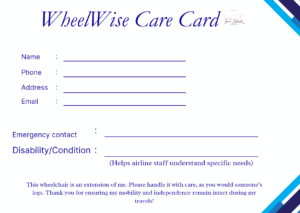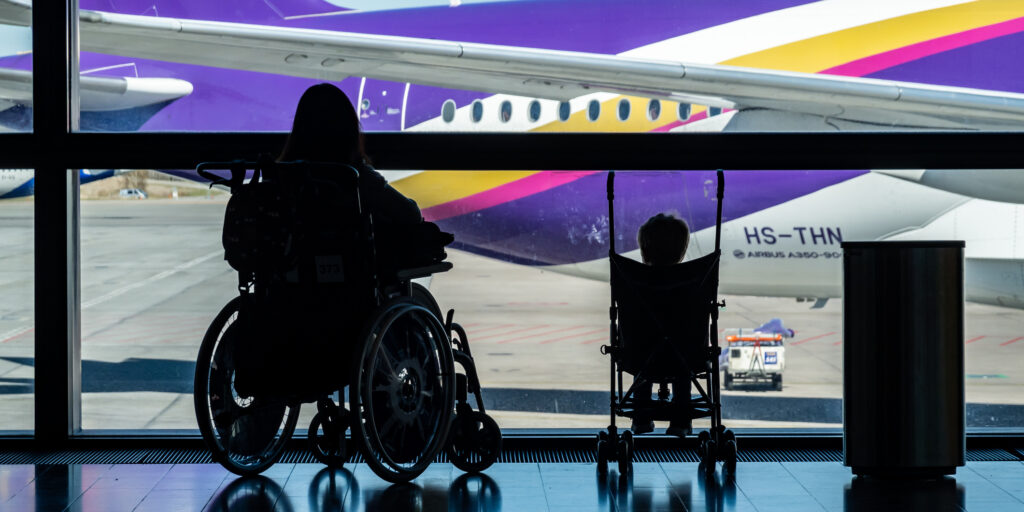
MDA Ambassadors Share Tips for Flying with Power Wheelchairs and Medical Equipment
By Amy Bernstein | Thursday, June 26, 2025
Air travel, even in the best circumstances, can be a little stressful. Flying with a power wheelchair or other mobility or medical equipment adds complications and hurdles to getting on an airplane.

Lyza Weisman loves to travel to new places.
But for many people with neuromuscular diseases, the benefits of travel are worth the challenges.
“Traveling is freedom; I love to see different things and places,” says Lyza Weisman, an MDA Ambassador living with spinal muscular atrophy (SMA). “That does not mean traveling is easy … but it is always worth it.”
Here, Lyza and other MDA Ambassadors share their best air travel tips and hacks.
Planning your trip
Experienced travelers know that planning ahead maximizes the chances of having a problem-free trip. Find tips for planning your destination, transportation, and more in Accessible Travel on a Budget: Smart Tips for Exploring Affordably.
The first rule of traveling with medical or mobility equipment is to inform the airline about your equipment and any assistance you need as early as you can.

On flights, Doug Clough brings a medical bag as a carryon.
“The most important thing I think I do is call the disability contact for the airline when making reservations. They can guide you through the whole process at the airport,” says Doug Clough, who lives with amyotrophic lateral sclerosis (ALS) and uses a power wheelchair.
Taking the time to gather as much information as you can, including your wheelchair’s specifications, can save headaches on departure day. “Providing the airline with details like weight, dimensions, and battery type helps them load and store your chair correctly,” says Sory Rivera, who lives with SMA.
Even with advance planning, you should arrive at the airport early, according to Sory. “Giving yourself extra time at the airport allows you to communicate with staff about your needs and ensure proper handling of your chair,” she says.
Sory also recommends taking pre-flight photos of your wheelchair. “Documenting your chair’s condition before check-in can serve as evidence in case of damage,” she says.
Packing and prepping equipment
While some medical equipment, like BiPAP machines, can be brought onboard as carry-ons, power wheelchairs must travel in the luggage compartment. That makes it even more important to protect your wheelchair and ensure it’s properly handled.

Tamara Blackwell wants airline staff to treat her wheelchair as an extension of her.
For example, Doug wraps bubble wrap around sensitive electronics that can’t be removed from his wheelchair. Many travelers also attach handling instructions to their wheelchairs.
“I’ve developed what I call the Wheelwise Card,’’ says Tamara Blackwell, who lives with limb-girdle muscular dystrophy (LGMD). She was inspired to make the card after a recent travel experience where her wheelchair was damaged. “This card includes sections where the chair owner can input vital information for airport workers, detailing precise specifications of their personal wheelchair and providing instructions on how to handle and store it correctly. I’ve personalized the card to emphasize the human aspect — hoping those handling my chair will see it not just as luggage, but as an essential part of my mobility and independence,” she says.
Lyza takes the extra step of translating the card she attaches to her power chair. “I have translated one side of the sheet to Spanish so more people can understand the instructions,” she says. “When I travel abroad, I translate one side into whatever language is the primary language of the country I am going to. I have also started attaching an Air Tag to my chair during the flight, just in case.”

Tamara Blackwell attaches this card to her wheelchair before checking it for a flight.
Experience has also taught Lyza that packing light isn’t always the best policy.
“Space is valuable, and with a ton of medical equipment, it is limited,” says Lyza. “Still, make sure to bring everything you need and perhaps a backup when traveling abroad. Make sure you understand what the voltage is in the country you are heading to.”
Having the right travel gear can help you travel more comfortably and confidently. Read Essential Gear for Traveling with a Disability for more tips on what to put on your packing list.
Ready for takeoff
When going through security at the airport, Lilly, a teenager living with Charcot-Marie-Tooth disease (CMT), communicates her needs to Transportation Security Administration (TSA) agents and requests not to take off her shoes. “It’s hard for me to tie my shoelaces and move that fast in line,” she says.

Lilly knows it’s key to communicate her needs while traveling.
TSA agents can and should modify security procedures to accommodate individuals with disabilities. For example, they can perform a seated screening if you can’t walk through the scanner, or they may test your shoes for traces of explosives if you can’t remove them.
The TSA offers a free service called TSA Cares, which allows you to submit a request for screening assistance in advance. This may help you get through airport security more quickly on your travel day.
It’s also important to communicate your needs to gate agents, who should allow passengers with disabilities to board early. “I also ask the flight attendants to help me with my bag since I can’t lift it,” Lily says. “I always try to check my [suitcase] and carry something light on the plane.”
Doug brings everything he needs for medical reasons in his carry-on. “The airlines allow an extra carry-on that is used as a medical bag. In that bag, I have my prescriptions and equipment I use, like my dense gel toilet seat cushion that helps prevent pressure sores,” he says.
“I carry a tool to help me open bottles, so I don’t have to ask anyone around me to do it,” Lilly adds. “Because my CMT hurts my hips and back, I try to get up and stand on longer flights.”
When you land

Planning ahead helps Sory Rivera relax on vacation.
Even with the most careful preparation, wheelchairs and other equipment can get damaged or lost during flight.
“If the airline damages your equipment, stop by the airline’s customer service desk BEFORE leaving the airport so they can file a claim. Airlines have mishandled my equipment, leaving me in difficult situations without my essential mobility device,” Sory says.
“When something happens, don’t get mad,” Doug says. “Staff members are much more willing to help someone who genuinely needs their help and appreciates that they deal with thousands of people, many of them mean and nasty. … Plus, there is no reason to let negativity into your vacation.”
While experienced travelers plan ahead, they also know that a plan can only take them so far. Travel is unpredictable, and being flexible can salvage a difficult situation. Learn how other travelers with neuromuscular diseases handle travel challenges in Travelers with Disabilities Share Their Top Tips to Avoid Mishaps.
Lyza emphasizes that adventure is part of the joy of travel. “You must be willing to try new things and work around problems — don’t let small things get in your way or stop you from enjoying the trip. Be open-minded and have fun,” she says.
Next Steps and Useful Resources
- Learn about recent policy and rule changes to make air travel safer and more accessible.
- Is Train Travel a Wheelchair-Friendly Alternative to Flying or Driving?Read this Quest article to find out.
- Gain practical tips for overcoming transportation barriers and learn about laws and protections with MDA’s no-cost Access Workshop: Access to Travel and Transportation.
- Stay up to date on Quest content! Subscribe to Quest Magazine and Newsletter.
TAGS: Accessible Air Travel, Ambassadors, Featured Content, Travel
TYPE: Blog Post
Disclaimer: No content on this site should ever be used as a substitute for direct medical advice from your doctor or other qualified clinician.




